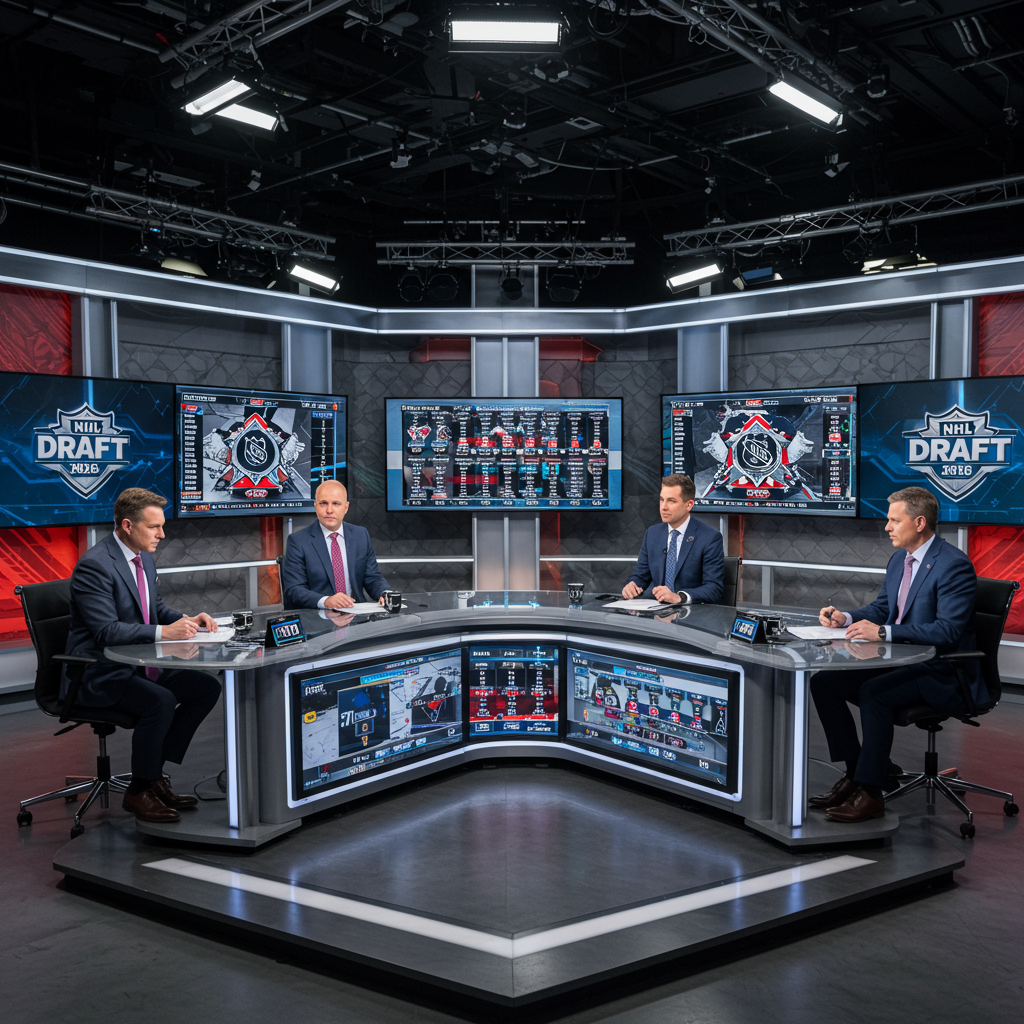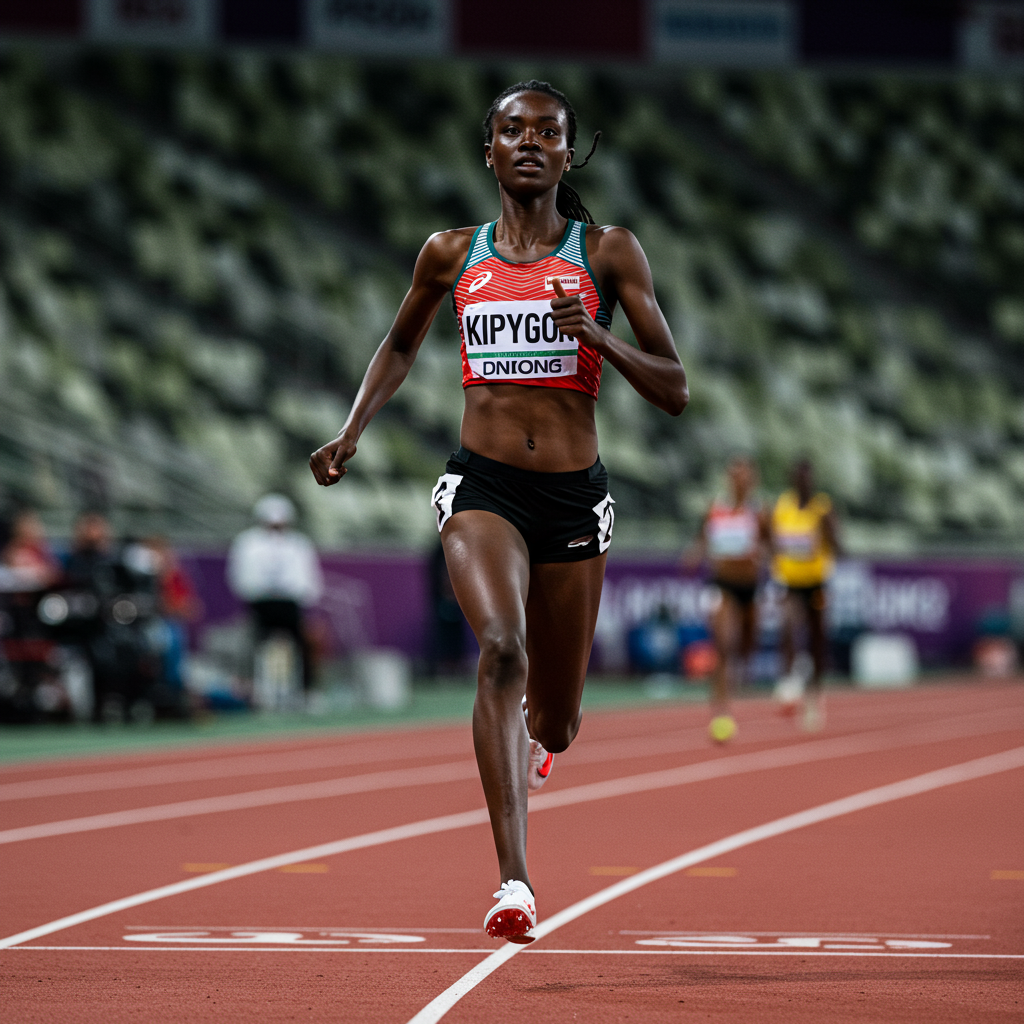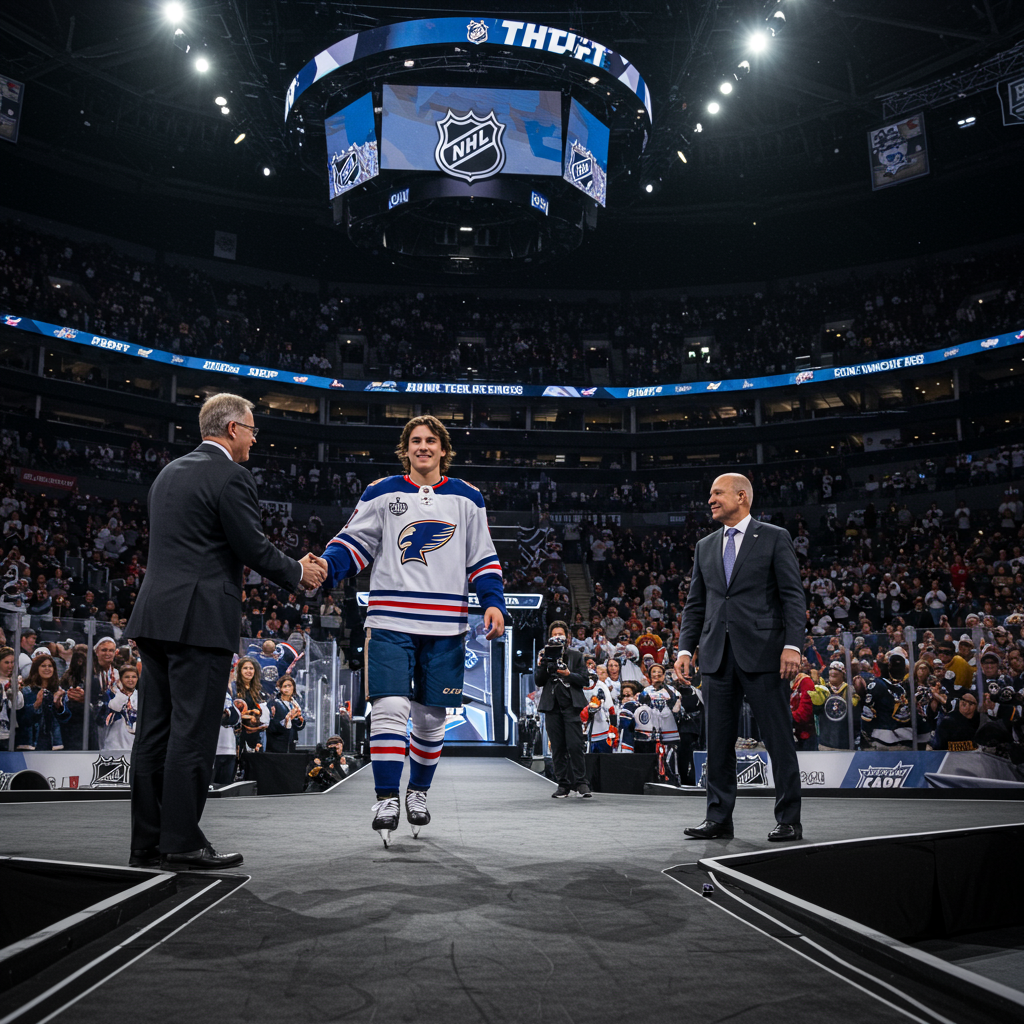The initial night of the 2025 NHL Entry draft is complete, and experts are weighing in. This first round delivered exciting picks, strategic decisions, and some unexpected moments that could shape franchises for years. An in-depth analysis breaks down how each team fared, evaluating their selections relative to where they picked and the total number of picks they held on Day 1. This isn’t about the overall depth of their prospect pool, but the immediate value added with these critical early selections. Who capitalized on opportunity? Which teams left analysts scratching their heads?
Unpacking the Expert Methodology
Analyzing an NHL draft isn’t just about picking the consensus top player. It requires deep scouting, understanding player potential, evaluating fit within an organization, and assessing value gained at a specific draft slot. This expert review is built upon a full year of rigorous evaluation—travel, video analysis, countless phone calls, and discussions with contacts throughout the league.
The focus is strictly on the picks made in the first round. Trades impacting draft position are noted but the value assessment centers purely on the prospect selected vs. their consensus rank and the team’s specific needs and draft capital coming into the round. The goal is to provide the most thorough and insightful breakdown available, sorting teams into distinct tiers based on their Round 1 performance: Winners, Overtime Winners, Overtime Losers, and Losers.
Winners: Striking Gold in Round 1
Some teams simply crushed the first round, landing top-tier talent and value picks that significantly bolstered their prospect pipelines.
New York Islanders: An Impressive Haul
The New York Islanders earned a top grade (A-plus) for their Round 1 performance. Securing the consensus number one prospect, Matthew Schaefer, with the first overall pick was expected. Schaefer has been the projected top pick for months, demonstrating impressive potential despite a draft-year injury. He’s seen as a potential franchise cornerstone, both on and off the ice.
Beyond Schaefer, the Islanders made two standout value picks later in the round. Victor Eklund, picked at 16th, was ranked significantly higher (as high as 8th) by some experts. He’s a competitive, fast, and skilled forward who plays with relentless energy – a style Islanders fans will appreciate. Kashawn Aitcheson, taken immediately after at 17th, is a tough, competitive defenseman known for his skating, shot, and hard defending. These three picks are seen as players who could fundamentally shape the Islanders’ future identity and winning culture.
Boston Bruins: Landing a Top Talent
The Boston Bruins landed a player many experts felt shouldn’t have fallen to them. James Hagens was taken at seventh overall, despite being widely viewed as a top-five talent in the draft class. Hagens’ availability at this pick was largely attributed to lottery results. As the Bruins transition as an organization, adding a premium center prospect was crucial. Hagens fits this need perfectly and is projected to be a future star in the league, capable of significant offensive production and potentially challenging for major awards in college next year.
St. Louis Blues: Capitalizing on Value
The St. Louis Blues made a savvy pick at 19th overall by selecting Justin Carbonneau. Rated much higher on some draft boards (around 12th), Carbonneau was a top forward in the QMJHL known for his high-grade shot and hands. Despite minor questions about his skating and consistency, his physical play and progress over the past two years suggest he has a real path to becoming a 30-goal scorer in the NHL. His confidence and ability to play through contact are significant positives.
Washington Capitals: High Upside Pick
The Washington Capitals took Lynden Lakovic at 27th overall, a player some teams had higher on their internal lists earlier in the teens. Lakovic has the ideal tools for a modern power forward: 6-foot-4 frame, good skating, real puck skill, and a strong shot. While scouts want to see more consistent intensity at his size, his high-end moments are undeniable. He drove offense effectively for his team and is a strong bet to outperform several players taken ahead of him.
Calgary Flames: Addressing Needs Effectively
The Calgary Flames had a clear organizational need for centers, and they addressed it decisively. They selected Cole Reschny at 18th overall and Cullen Potter at 32nd. Reschny, though undersized at 5-foot-10.5, is a strong, competitive, and smart two-way center – seen as an excellent fit for the team’s system. Potter is another undersized player with elite skating and skill, though he may project as a pro winger. The Flames scouting department doesn’t shy away from size if the talent and compete level are there, and these picks were seen as high-value swings that hit their targets.
San Jose Sharks: Adding Elite Pieces
Coming into the draft with multiple high picks, the San Jose Sharks had the opportunity to add foundational pieces. They selected Michael Misa at second overall and Joshua Ravensbergen at 30th. While the decision at second was reportedly debated internally, Misa is widely considered the top forward in the class and adds significant offensive firepower and flexibility to a young core that already includes Macklin Celebrini and Will Smith. Ravensbergen is a raw but intriguing goalie prospect at 6-foot-5 with serious talent and upside, despite a recent injury history. Securing potential cornerstones at both forward and goalie makes for a strong first round.
Ottawa Senators: Smart Draft Strategy
The Ottawa Senators moved back in the draft order to acquire additional draft capital, then selected Logan Hensler at 23rd overall. Hensler is a large, right-shot defenseman with promising skating and offensive tools. Projecting as a potential top-four defenseman, he fits a need for the Senators. While he needs to develop a more physically assertive and commanding presence, his underlying skills and physical tools are highly regarded. He’s compared to effective two-way defensemen who can contribute across situations, making this a solid pick that also improved their draft capital.
Overtime Winners: Good Value, Minor Questions
These teams had positive first rounds, landing talented players, but perhaps with slight caveats or interesting strategic choices that lead to minor debate.
Nashville Predators: Style Over Talent?
The Nashville Predators selected Brady Martin at fifth overall, a player highly regarded around the league for his fierce competitiveness and unique throwback style. Martin fits the Predators’ organizational identity perfectly. However, some experts felt they passed on potentially higher-ceiling offensive talents like James Hagens or Porter Martone who were still available. While Martin could become a valuable, hard-driving forward, there’s a lingering question if they missed an opportunity to add a true game-breaking point producer needed by the team. Despite this, their later picks of Cameron Reid (21st) and Ryker Lee (26th) were seen as excellent value, adding well-rounded defense and dynamic offensive skill, respectively.
Winnipeg Jets: Addressing a Key Need
The Winnipeg Jets’ prospect pool is notably thin on defensemen. Their pick at 28th overall, Sascha Boumedienne, directly addressed this critical need. Boumedienne is a plus-skater with the frame and developing tools to profile as an NHL defenseman. While his decision-making requires refinement, he showed significant progress late in the season. This pick was essential for the Jets to add depth to their blue-line prospects.
Anaheim Ducks: A High-Upside Swing
With an already deep forward pool, the Anaheim Ducks could afford to take a calculated risk. They selected Roger McQueen at 10th overall. McQueen is a large (6-foot-5), highly skilled center with excellent hockey sense. A previous back injury may have caused some teams to hesitate, but the Ducks clearly felt comfortable with his health. McQueen adds another element of size and talent to their forward group, fitting alongside players like Leo Carlsson and Mason McTavish. If he hits his ceiling, he could be a top-of-the-lineup player.
Buffalo Sabres: Targeting Their Guy
The Buffalo Sabres made a move for a player they had reportedly targeted for a while. Radim Mrtka was selected at ninth overall. Mrtka is a massive defenseman (nearly 6-foot-6) with impressive mobility for his size and poise with the puck. While some scouts wanted to see him impose himself physically more consistently, his rare combination of size and skating, combined with a legitimate puck game, aligns perfectly with the league’s trend towards drafting long, mobile defensemen. Experts were high on Mrtka, and the Sabres got their desired player.
Utah Mammoth: Finding a Future Centerpiece
Utah made a solid pick at fourth overall, selecting Caleb Desnoyers. Widely seen as one of the most complete and well-rounded prospects available, Desnoyers is considered a “sure thing” to remain a center in the NHL due to his strong defensive details, faceoff ability, and high hockey sense. He projects as the future second-line center behind Logan Cooley and is described as having a natural leadership aura. This pick felt like a natural and logical fit for the new franchise.
Seattle Kraken: Adding More Forward Talent
Despite having used recent high picks on centers like Matty Beniers and Shane Wright, the Seattle Kraken selected another center, Jake O’Brien, at eighth overall. O’Brien was considered the consensus best player available at that pick by many. He’s lauded as one of the smartest players in the draft class with high-end skill and playmaking ability. While the team might need to consider positional flexibility down the road, adding O’Brien gives them an exciting quartet of young forwards to build around, capable of making their linemates better through intelligence and skill.
Overtime Losers: Missed Opportunities or Reaches?
These teams made picks that experts felt represented slight reaches based on consensus rankings or perhaps missed opportunities to capitalize on better value elsewhere in the round.
Columbus Blue Jackets: Questionable Positioning
The Columbus Blue Jackets entered the draft needing defensive prospects after trading David Jiricek. They addressed this by selecting Jackson Smith, a 6-foot-4 defenseman, at 14th overall. Smith has promising physical tools (build, skill, skating) but needs significant work on his game reading and decision-making. He fills a need but was considered a slight reach by some. Their later pick, goalie Pyotr Andreyanov (20th), was highly ranked by the author (2nd among goalies), but questions remain if they could have potentially drafted him later, perhaps after trading down, given his ranking by others. They got their targeted positions (D and G), but maybe not optimal value.
Chicago Blackhawks: The Size Gamble
The Chicago Blackhawks clearly aimed to get bigger in this draft, adding players with significant size. They selected Anton Frondell at third overall, a big forward who provides size, strength, and a strong shot, potentially fitting alongside Connor Bedard or as a second-line center. While highly regarded, Frondell was ranked slightly lower by some compared to other available players like Hagens or Martone, who didn’t fit their skating or size priorities. Their later picks, Vaclav Nestrasil (25th) and Mason West (29th), also reflected this size priority. Nestrasil is a big, hardworking winger seen more in the late-first/early-second range. West is a “fascinating gamble”—a huge athlete from a lower-level competition sample who also plans to play football, raising questions about focus and injury risk. While their deep pool allows for risks, these picks felt like reaches tied specifically to a size mandate.
Vancouver Canucks: Playing it Safe
The Vancouver Canucks needed to add a significant center prospect to their pool. They selected Braeden Cootes at 15th overall. Cootes is a well-rounded, competitive right-shot center who captained Team Canada at the U18s. While he fills a definite need and is well-liked, his offensive production didn’t jump off the page, especially for an undersized center picked in the mid-first round. Some experts were significantly lower on him than his draft slot, feeling the Canucks played it too safe when they could have prioritized adding higher-upside skill players still on the board.
Losers: Draft Night Challenges
These teams faced challenges in the first round, making picks that analysts felt were significant reaches or questionable strategic choices that didn’t align with available talent or optimal value.
Los Angeles Kings: Potential Downside
The Los Angeles Kings picked defenseman Henry Brzustewicz at 31st overall. While he’s a strong, sturdy player who benefits from the development reputation of his junior team (“London bump”), some experts ranked him considerably lower (as low as 51st). There are questions about his decision-making, and while he projects as a solid third-pairing defenseman, achieving more than that would require significant steps forward. This pick carries some perceived downside based on his draft slot.
Pittsburgh Penguins: Questionable Draft Strategy
The Pittsburgh Penguins’ first round was marked by unexpected picks and positioning. Benjamin Kindel was selected at 11th overall, a significant reach based on his consensus late-first round projection (around 21st), even though he’s a highly intelligent offensive player with top-six potential. Bill Zonnon was taken at 22nd, also slightly higher than expected for a solid top-nine winger prospect. The pick that drew the most criticism was William Horcoff at 24th overall. Despite showing some recent improvements, Horcoff is described as lacking natural playmaking ability, high hockey intelligence, and ideal skating, projecting more as a third-line forward. Picking a projected third-liner this high felt like a significant misstep. While they added prospects, the overall strategy felt suboptimal in terms of maximizing value for their picks.
Players not selected in the first round, particularly those ranked just outside the top 32, create an exciting group of prospects available to start Day 2. Teams looking to add depth and potentially find hidden gems will have opportunities early in the second round.
Frequently Asked Questions
What were the key outcomes of the 2025 NHL Draft first round analysis?
The analysis evaluated each team’s first-round performance based on the value of their picks relative to their draft position and capital. Teams were categorized into four tiers: Winners, Overtime Winners, Overtime Losers, and Losers. The New York Islanders were highlighted as major winners, while teams like the Pittsburgh Penguins faced criticism for their selections. The draft saw teams targeting specific needs, taking high-upside swings, and sometimes reaching for players based on organizational priorities.
Which teams were identified as ‘Winners’ in the first round and why?
The New York Islanders were graded A-plus for securing consensus #1 prospect Matthew Schaefer and landing significant value picks in Victor Eklund and Kashawn Aitcheson later in the round. The Boston Bruins won by getting James Hagens, a top-five talent who fell to pick seven. Other winners included the St. Louis Blues (Carbonneau), Washington Capitals (Lakovic), Calgary Flames (Reschny, Potter addressing center need), San Jose Sharks (Misa, Ravensbergen adding elite pieces), and Ottawa Senators (Hensler value after trading back).
Who were some notable prospects mentioned as value picks or potential stars?
Several players were highlighted for their value or potential. James Hagens (Bruins) was seen as a potential star who fell in the draft. Victor Eklund (Islanders) was a significant value pick at #16. Justin Carbonneau (Blues) and Lynden Lakovic (Capitals) were noted for their high-end tools picked later than some expected. Michael Misa (Sharks) was confirmed as an elite forward prospect. Caleb Desnoyers (Utah) was praised as a complete center prospect, and Jake O’Brien (Kraken) as a smart, skilled player available at #8.
Conclusion
The first round of the 2025 NHL Draft set the stage for the future of many franchises. While the New York Islanders clearly stood out with an exceptional night, other teams like the Bruins and Sharks also made impactful selections. Conversely, teams like the Penguins faced criticism for perceived reaches and questionable draft strategy. Day 2 promises more action and opportunities for teams to continue building their organizational depth with the remaining prospects. Monitoring the development of these players over the coming years will be key to truly assessing the success of each team’s draft class.



